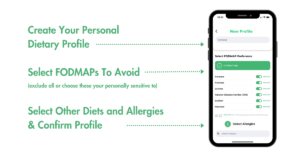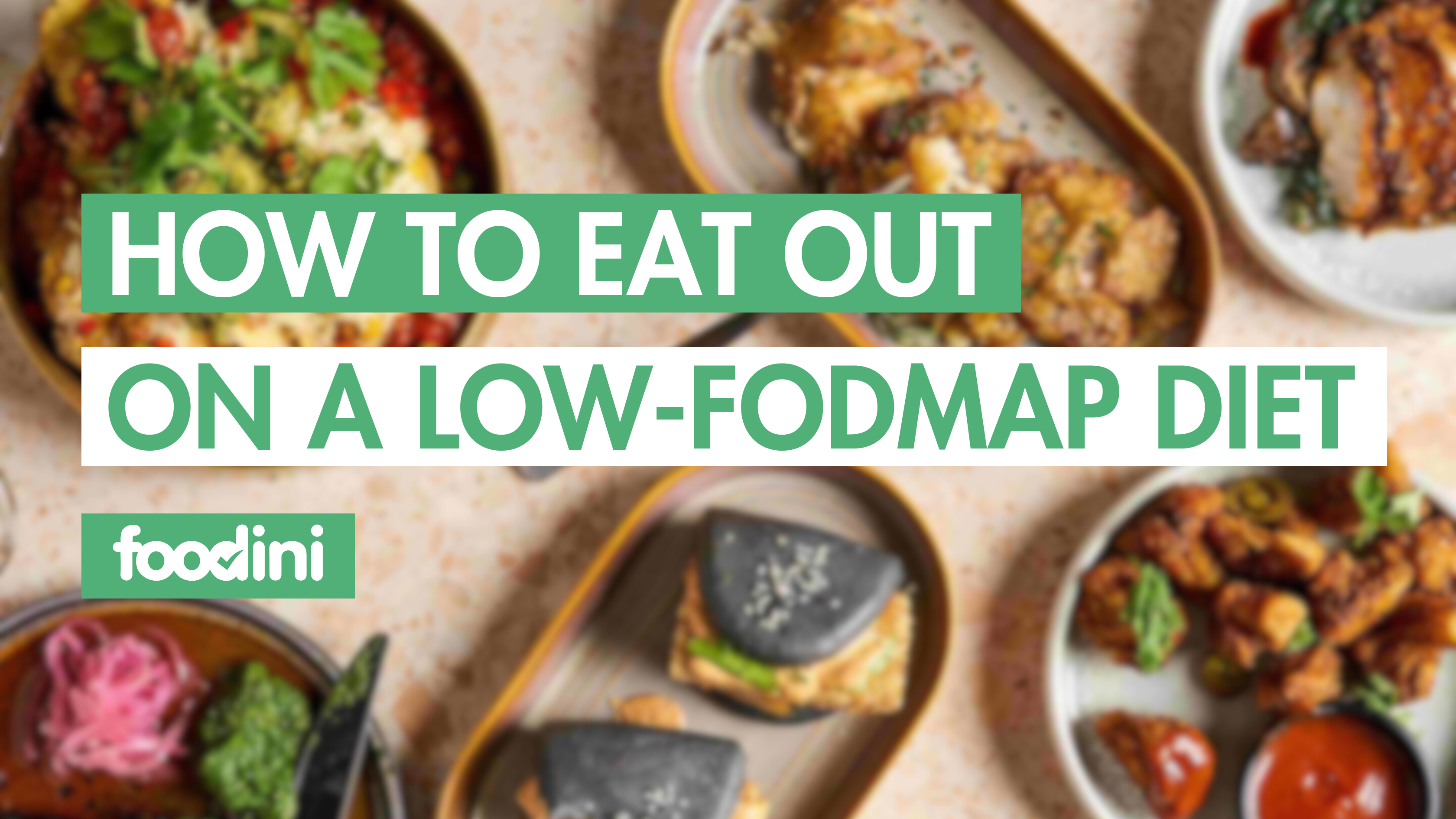Going out to eat can be a challenge when you’re following a low FODMAP diet. FODMAPs are a group of carbohydrates poorly absorbed in the small intestine and can cause digestive symptoms in some individuals. However, with some preparation and communication, you can still enjoy dining out without triggering unpleasant symptoms. In this article, we will guide you through eating a low FODMAP diet at a restaurant, from understanding the diet to dealing with potential challenges. While many find dining out on such a specific diet intimidating, tools like Foodini make this challenge much more navigable.
Let’s dive in!
What is a Low FODMAP Diet?
Before we discuss how to eat a low-FODMAP diet at a restaurant, let’s first understand what the diet entails. The acronym FODMAP stands for Fermentable Oligosaccharides, Disaccharides, Monosaccharides, and Polyols – types of carbohydrates that may cause gastrointestinal symptoms in individuals with irritable bowel syndrome (IBS).
Developed by researchers at Monash University in Australia, this dietary approach has shown promising results in reducing the frequency and severity of symptoms in individuals with IBS.

A low FODMAP diet involves avoiding foods high in FODMAPs and focusing on those low in these carbohydrates. FODMAPs are found in various foods, including certain fruits and vegetables, grains, dairy products, sweeteners, and beverages. These carbohydrates are poorly absorbed in the small intestine. They can be fermented by bacteria in the large intestine, producing gas and other byproducts that can cause discomfort.
Reducing your intake of high-FODMAP foods can alleviate IBS symptoms such as bloating, gas, abdominal pain, and diarrhoea. It is important to note that the low-FODMAP diet is not a long-term solution but a short-term elimination diet. After strict avoidance, FODMAP foods are gradually reintroduced to identify individual triggers and establish a personalised diet plan.
Benefits of a Low FODMAP Diet
Following a low FODMAP diet at a restaurant can be challenging, but its potential benefits are worthwhile.
- Many individuals with IBS have reported reduced symptoms and an improved quality of life when following a low FODMAP diet. By adhering to this dietary approach, you can enjoy a meal without the worry of triggering digestive discomfort.
- One of the key benefits of the low FODMAP diet is its individualised approach. You can tailor your diet to suit your needs by identifying and eliminating specific trigger foods. This personalised approach helps manage IBS symptoms and empowers you to take control of your health and well-being.
- While it may seem restrictive initially, it promotes consuming whole, unprocessed foods naturally low in FODMAPs. This means you can still enjoy various low-FODMAP fruits, vegetables, proteins, and grains while following the diet. It is essential to do so.
- Emerging research suggests that the diet positively influences the gut microbiota, the complex community of microorganisms in our digestive system. By reducing the intake of FODMAPs, which can feed certain bacteria in the gut, the diet may help restore a healthier balance of gut bacteria and improve overall gut function.
While the low FODMAP diet may require some adjustment and careful planning, its potential benefits make it a worthwhile dietary approach for individuals with IBS. By understanding the principles behind the diet and seeking guidance from a healthcare professional or registered dietitian, you can successfully navigate the challenges of eating out while managing your symptoms and improving your overall well-being. Following a low FODMAP diet while eating out has never been easier, with platforms like Foodini ensuring you don’t miss out on the joy and convenience of eating out.
Preparing for Your Restaurant Visit
Now that you understand the low FODMAP diet, it’s time to prepare for your restaurant visit. With some research and planning, you can make informed choices and enjoy a delicious meal that fits your dietary restrictions. This time-consuming process can be solved using tools & apps, for example, using Foodini to pinpoint venues that cater to a low-FODMAP diet, saving you time and potential disappointment.
1. Researching Restaurant Menus
Before choosing a restaurant, it’s helpful to research their menu. Many restaurants now provide their menus online, making it easier to find low FODMAP options. Look for dishes naturally low in FODMAPs, such as grilled meats, seafood, vegetables, and gluten-free options, which can be quickly done after selecting FODMAP in your dietary profile on the Foodini app. You can also contact the restaurant directly and inquire about their common FODMAP choices. When researching restaurant menus, it’s essential to consider the main courses, side dishes, and sauces. Some sauces may contain high FODMAP ingredients like garlic or onion, so asking about the ingredients or requesting a modification is essential.
Quick Tip – Seeking Input from fellow Low-FODMAP Enthusiasts:
Additionally, remember that some restaurants may have seasonal menus or daily specials that may not be available online, so it’s always a good idea to call ahead and inquire about the current offerings. Another helpful tip is to read online reviews or check out social media platforms where people share their dining experiences. Look for reviews from individuals who follow a low FODMAP diet or have similar dietary restrictions. They may provide insights into specific dishes or restaurants catering to those with dietary needs.
2. Identifying Low-FODMAP Foods
Having a good understanding of low-FODMAP foods is essential when dining out. Familiarise yourself with the FODMAP content of common ingredients and food groups. For example, you might opt for low-FODMAP fruits like strawberries and bananas and avoid high-FODMAP ones like apples and pears. This practice will become second nature over time. Plus, having dietary companion apps such as Foodini will help guide your choices when faced with unfamiliar menus.
Vegetables:
Regarding vegetables, some low FODMAP options include spinach, carrots, bell peppers, and zucchini. However, certain vegetables like onions, garlic, and mushrooms are high in FODMAPs and should be avoided or consumed in limited quantities. Proteins like chicken, turkey, beef, and fish are generally low in FODMAPs. However, checking for marinades or seasonings containing high FODMAP ingredients is essential. Grilled or baked options are often safer than fried or breaded ones.
Grains and Carbohydrates:
Regarding grains and carbohydrates, gluten-free options like rice, quinoa, and gluten-free bread are usually low in FODMAPs. It’s always a good idea to ask the restaurant staff about the ingredients in their gluten-free options to ensure they suit your dietary needs.
Beverages:
Lastly, beverages can also contribute to your FODMAP intake. While water, coffee, and tea are generally safe options, it’s essential to be cautious with certain fruit juices, sodas, or alcoholic beverages containing high FODMAP ingredients or sweeteners.
By familiarising yourself with low-FODMAP foods and ingredients, you’ll be better equipped to make informed choices when dining out. Remember to communicate your dietary needs to the restaurant staff, who can provide additional guidance or modifications to accommodate your restrictions.
3. Communicating Your Dietary Needs
After arriving at the restaurant, you must communicate your low-FODMAP dietary needs to the waiting staff. By being clear and specific about your requirements, you can ensure a safer dining experience. Preparation is vital in conveying your necessities more easily; apps like Foodini can help direct conversations, ensuring you receive the correct meals to suit your needs.
Discussing Your Low-FODMAP Diet with the Waiters
When the waiter approaches your table, politely explain that you have specific dietary restrictions and require a low FODMAP meal. Tell them you’re following this diet to manage IBS symptoms if you feel comfortable. By being upfront about your needs, the waitstaff can assist you in making suitable choices. It’s important to remember that not all waitstaff may be familiar with the term “FODMAP.” Take a moment to explain that FODMAPs are certain types of carbohydrates that can trigger digestive symptoms in some individuals. Let them know you are looking for dishes free from these specific carbohydrates. The waitstaff may ask you for more details about your dietary restrictions. Be prepared to explain which FODMAPs you avoid, such as fructose, lactose, or certain sugar alcohols. This will help them understand your needs better and provide you with appropriate options.
Asking the Right Questions
To ensure your meal is low in FODMAPs, don’t hesitate to ask questions about the menu and how dishes are prepared.
Inquire about:
- Ingredients
- Cooking methods
- Potential hidden sources of FODMAPs
For example, ‘Is there onion or garlic present in this dish, as these ingredients are high in FODMAPs?’
Proactively asking questions will help you make informed decisions. When discussing the menu with the waitstaff, you can also inquire about alternative ingredients or substitutions that can be made to accommodate your dietary needs. For example, if a dish contains high-FODMAP ingredients like wheat pasta, you can ask if gluten-free pasta is available as a substitute. Understanding all the low-FODMAP foods can be overwhelming, and finding alternatives and substitutions can be an even further challenge. Luckily, apps like Foodini have built-in ‘suggested alternatives’ to give you options for what ingredients to swap to fulfil your dietary requirements.
Remember, it’s essential to communicate any food allergies or intolerances in addition to your low FODMAP requirements. This will ensure that the waitstaff knows all your dietary restrictions and can take necessary precautions.
Quick Tip – To Achieve Peace of Mind:
Additionally, if you have any concerns about the kitchen’s ability to accommodate your needs, feel free to ask if they have a separate preparation area or follow specific protocols for handling allergens and dietary restrictions. Knowing that the restaurant takes these precautions can give you peace of mind. By actively engaging with the waitstaff and asking the right questions, you can navigate the menu more effectively and enjoy a delicious meal that meets your dietary needs. Remember, being proactive and clear about your requirements is always better to ensure a safe and enjoyable dining experience.
Navigating the Menu on a Low-FODMAP Diet
With your dietary needs communicated and your questions answered, it’s time to navigate the menu and make your selections. Here are some tips to help you choose low-FODMAP dishes in each course.
1. Low FODMAP Appetizers and Starters
For appetisers, opt for dishes that are light and vegetable-based. Salads without high FODMAP ingredients like onions and certain dressings can make a great choice. Grilled or steamed seafood options like shrimp or calamari are often low FODMAP. Be cautious of breaded or deep-fried foods, as the breading may contain high FODMAP ingredients.
2. Main Course Selections
Regarding the main course, lean proteins like grilled chicken, turkey, or fish are usually safe options. Pair your protein with low-FODMAP vegetables or a side salad. Avoid heavy sauces or glazes, as they may contain high FODMAP ingredients like honey or garlic.
3. Desserts and Drinks on a Low FODMAP Diet
Look for desserts made with low FODMAP ingredients to satisfy your sweet tooth. Fresh fruit, gelato, or sorbet can be excellent choices. Avoid desserts with high FODMAP ingredients like wheat, dairy products, or artificial sweeteners. As for drinks, stick to water, tea, or coffee without milk or high FODMAP sweeteners.
Apps to Help with Dining Out on a Low-FODMAP Diet
Transitioning to and maintaining a low-FODMAP diet while dining out can often feel like an uphill task. Nevertheless, there is always an app to help. A helpful app called Foodini can help make dining out on a low-FODMAP diet easier & more flavorful. With thousands of dietitian-reviewed meals, you can select the FODMAP diet while creating your profile. Foodini will offer menu matches near you, ensuring you can enjoy a meal out with friends or family without compromise.

Dealing with Potential Challenges
Despite your best efforts, some challenges may arise when eating a low FODMAP diet at a restaurant. However, by being aware of these challenges and having strategies in place, you can overcome them and still enjoy your meal.
Managing Unexpected Ingredients
Despite your best efforts, your meal may have hidden sources of high FODMAP ingredients. This can happen if the chef uses certain sauces, stocks, or pre-made ingredients that contain FODMAPs. If you suspect the dish may not be entirely low FODMAP, consider asking staff a little more or selecting an alternative meal. Pay attention to your body’s response and make note of any symptoms for future reference. Now that you thoroughly understand how to eat a low FODMAP diet at a restaurant, it’s time to put this knowledge into practice. Remember to plan, use tools like Foodini, communicate your needs clearly, and make informed choices from the menu. Following these tips, you can enjoy a delicious meal without compromising your low FODMAP diet.
Bon appétit!

